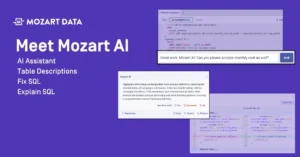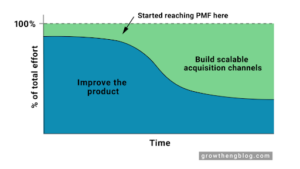Data can be a powerful tool for businesses, but particularly with large data sets, it can be very difficult to sort through the volume to access the insights needed to drive your business forward. And it’s not just giant companies that can find themselves wrestling with large data sets: almost any business can run into these challenges, whether it’s because they’re collecting data to better understand customer behavior, dig deeper into marketing and sales activity, or are simply tracking their own operations.
The key to utilizing this data is data transformation, which allows you to organize the data you actually need for analysis. We think the easiest, most efficient way to do this is with Mozart Data’s modern data stack, but the insights we’ll share with you here can be acted upon without Mozart’s help as well.

What is data transformation?
We get deeper into the details of what data transformation is in this blog, but we’ll cover the basics here as well. Data transformation involves changing some of the essential attributes of raw data, such as its format, values, and structure.
There are a number of types of data transformation:
-
Aesthetic transformation involves stylistic changes, such as standardizing street names or other values. An example: reformatting “jon doe” to “Jon Doe”.
-
Structural transformation involves combining and/or moving columns. For a revenue analysis example, the amount of spend to acquire customers and the number of customers gained can be combined to identify customer acquisition cost (CAC).
-
Constructive transformation is where raw data is added, copied, and replicated to fill gaps and standardize the data. For example, you could take raw information about the number of site visits you had on each day in a month and create an average daily site visitors for each week or the entire month.
-
Destructive transformation is where entire fields and records may be deleted to clean the data and make it more useful. An example would be removing personal identifiable information (PII) from data when it is not needed.
Data transformation tools are needed for any of these types of data transformation. There are tools that can help with any stage of the data process. Some data engineers use the scripting language Python for data transformation. Another language, SQL, is often used. Mozart Data’s transform tool is built for SQL users because we believe it is robust enough to transform data effectively and can be learned quickly by less experienced technical users.
Mozart Data’s transform tool also enables incremental data transformations, something we will highlight again later on.
Think of Data Insights Like Sculpting a Work of Art. No, Really.
Before a marble statue is a beautiful work of art, it’s just a block of stone. The sculptor’s art comes about by chipping, grinding, and polishing stone away until all that’s left is the statue, the art. It’s not just about having all of the tools to remove stone from the block — it’s about knowing what the statue is going to be, so the goal can be worked towards.
Data insights are surprisingly similar, especially when they’re hidden in a large data set. It’s necessary to know what one is looking for to properly transform the data. Sometimes this is easy: if a company wants to know how many customers they’ve had, or the number of sales, all that is required is a simple count. The transformation for a report can be as simple as collecting the account information that contains those figures and then removing superfluous data, like contact information, that isn’t needed right now.
It’s important to understand in this example that removing information is excluding it via transformation. You don’t have to delete data from your data warehouse to find the answers you want, you just need to use a transformation to show the data you need and only the data you need.
But some asks are more complicated, and valuable insights might require asking another set of questions. Let’s say leadership wants to know how effective email campaigns are. One of the first questions people want to ask is, “what’s the open rate for emails?”. It isn’t particularly difficult to look at open rates in whatever platform is used to send emails, like Hubspot or Marketo. It will take some work, but you should be able to pull together a pool of all emails sent and find that open rate too.
The reason it’s important to understand the “Why?” behind the request is that these figures might not actually be particularly valuable. It’s probably important to be able to segment email recipients: new subscribers probably behave differently than valued customers that have been loyal to your business for years. Promotional emails offering a discount likely have a different open rate in February than they do on Black Friday, and they almost certainly have a different open rate than an email sent describing a new product feature.
What about the impact of time? If your company has been sending emails for ten years, historical data can be valuable, but you want to know if anything has changed significantly in the last few months.
This is what data transformation is for, and it’s why we think the first step is having an idea of what’s actually important, from a business perspective. No level of SQL or Python knowledge can unlock valuable insights if the wrong questions, and follow-up questions, are being asked.
Incremental Data Transformation
Mozart Data has introduced the ability to perform an incremental transform to make the process of transforming data more efficient. Less time consuming = less expensive.
A traditional transform completely replaces all the data with new data. If the amount of data being queried is very large, the query can take a lot of time and cost more. For vital reports that need to be up-to-date on short notice or every day, the costs can rapidly add up while those who need the insights are frustrated by delays.
An incremental transform does not replace all of the data. Instead, it can be written to only include data that would modify the existing data. For a practical example, think about a table that includes every customer your business has ever had. If you want to update that table to include customers that came in today, you don’t need to refresh the entire table. You just need to run a transform that will update with new customers. This can be done with an incremental transform.
Incremental transforms can also be valuable for narrowing down a timeframe. If you’re viewing customer activity, your team’s production, or any other information and want to focus on the last 90 days, an incremental transform can be used to highlight this specific information without a) taking a great deal of time or b) modifying your existing historical data in a way that might require you to re-do work later when you need access to it.
Identifying Opportunities to Transform Your Data
Great data analysis involves finding opportunities to transform data that make it more useful. One place to look is data that is constant throughout a data set you’re working with. Is there a column that contains the same information for every single row? This is an opportunity to transform your data to make it more useful. Sometimes a consistent response to a Yes/No is useful to display, but oftentimes it means you either don’t need to show that data or that the data could be used to better define the report or table you’re working on. For example, if a company is looking at a certain user behavior on their site and the “Logged In?” column always has a “Yes” answer, this is definitionally a table of Logged In Users. Understanding the context of Yes/No questions can help define data analysis work.
Another important thing to consider is data grain, or how granular data needs to be for a given task. For a company with an e-commerce option, it’s helpful to know when customers are most active to drive sales and marketing activity, manage inventory and shipping resources, and maintain customer support. While there are still other applications for weekly, monthly, and yearly sales volume, optimizing these processes requires access to data broken down day and even by the hour. However, there likely isn’t a great deal of utility for breaking this information down by the minute or second, even if you have access to that information. This is an opportunity to transform data in a way that makes insights easier to identify, not harder, which is always the goal with data transformation.
Mozart Data offers an out-of-the-box modern data stack that can be set up in just a few hours. You can connect all of your sources of data and pull data into a best-in-class warehouse, where you can organize and transform your data for analysis. With just a bit of SQL knowledge, you can start accessing insights to drive your business forward.


